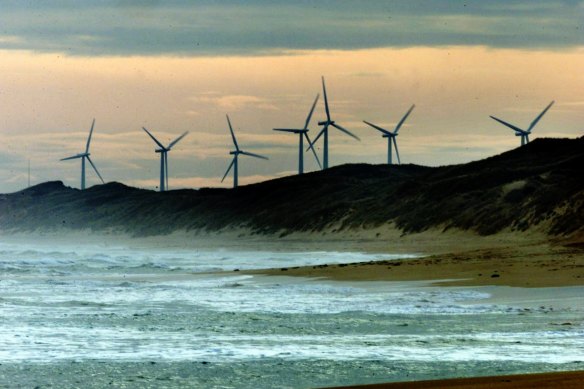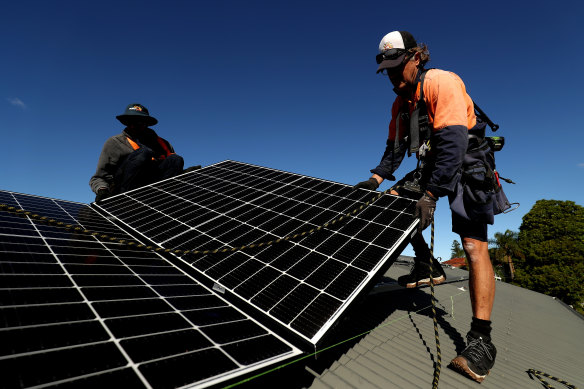Save articles for later
Add articles to your saved list and come back to them any time.
Significant growth in clean energy output and the impact of emergency fossil fuel price caps are continuing to drive down wholesale electricity costs on the eastern seaboard from last year’s unprecedented highs.
Figures to be released on Friday reveal wholesale prices – what retailers pay for power supply before they sell it to their customers – averaged $83 per megawatt-hour in the first three months of the year, down from $93 in the prior quarter and $216 in the September quarter.
Large-scale renewable energy and rooftop solar panels pushed wholesale power prices below $0 more often than ever for this time of the year.Credit: Joe Armao
The Australian Energy Market Operator (AEMO) said the latest declines were being driven by record output from rooftop solar panels slashing grid demand to its lowest first-quarter levels in 18 years, while the build-out of more wind and solar farms was increasing supplies and squeezing expensive coal- and gas-fired power further from the mix.
Coal remained the power grid’s largest contributor, accounting for 58 per cent of generation across the quarter. However, the influx of wind and solar farms coupled with the boom in rooftop solar have continued radically reshaping the market, with renewable energy’s share of output rising 4 per cent to 37 per cent of generation.
The uplift in renewable energy helped push wholesale power prices to $0 or below – levels where Australia’s dominant coal-fired generators are forced to run at a loss – more often than ever before for this time of the year.
“Growing renewable output across the national electricity market helped drive a first-quarter record, with 12 per cent of dispatch intervals having negative or zero prices,” AEMO chief executive Daniel Westerman said.
Last year’s steep increases in coal and gas prices, driven by the war in Ukraine worsening a global scramble for spare cargoes of fossil fuels, led to an increase in the cost of supplying electricity from Australia’s major power stations and contributed to record-high average wholesale prices across the grid.
The wholesale increases have forced energy regulators to lift “default market offers” – the main caps on what retailers can charge customers who do not take up a special deal – by between $300 and $564 a year from July 1.
In a bid to blunt even bigger possible bill rises, state and federal governments in December imposed 12-month caps on the domestic price of black coal to reduce the cost of running power stations and keep a lid on wholesale prices.
AEMO’s new report shows large power stations that burn black coal made more bids to supply the grid at lower prices during the quarter following the passage of emergency caps.
The boom in rooftop solar has contributed to reshaping the energy market. Credit: Bloomberg
“Black coal generators in NSW and Queensland have increased offer volumes in lower price bands following the announced caps on thermal coal prices, which has decreased the average price set by black coal generators,” Westerman said.
Energy and Climate Change Minister Chris Bowen said the latest figures from AEMO demonstrated that the government’s energy price relief plan was working.
“While we aren’t out of the woods yet, the government intervention has delivered wholesale electricity prices this quarter that are not only lower than their peaks during the winter energy crisis, but lower than what the Coalition left us with after 10 years of denial and delay,” he said.
“We know Australian households and businesses are feeling the cost-of-living crunch, and the government is continuing to act, providing targeted energy bill relief for households and businesses, and driving investment in cleaner, cheaper, and more reliable energy in the upcoming budget.”
Electricity futures contracts for the next financial year – those bought by retailers and large customers to lock in power supplies at a later date – averaged $107 a megawatt-hour, a decrease of $55 on the prior quarter.
Westerman said the March quarter statistics had reinforced the urgent need for greater investment in building more critical transmission infrastructure to better-enable the flow of cheap renewable electricity across the country, especially from the southern states into the north.
“This is clear with the projects in Victoria’s Murray River renewable energy zone that are burdened with generation impacts,” he said.
The Business Briefing newsletter delivers major stories, exclusive coverage and expert opinion. Sign up to get it every weekday morning.
Most Viewed in Business
From our partners
Source: Read Full Article



